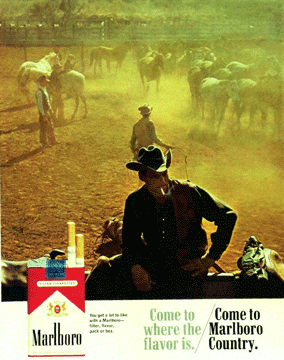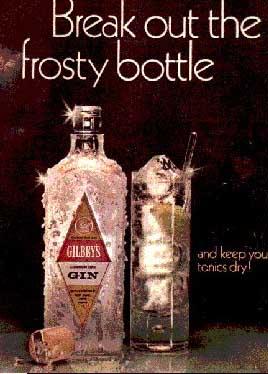Tiffany Kimmel - The Suggestive Symbols of Advertising
|
Advertising is art with ulterior motives. It is
used to attract consumers' attention and make them believe that one
brand is better than another or that they need something that they
really do not. Advertising indirectly sets many cultural norms. It
plays on many common beliefs, hoping to relate to the majority of
the consumers. There are many popular methods for getting such messages
across. One that I will look at is that of subliminal messaging. In
this paper, I will focus on the symbolism involved in advertising.
|
|
There are several key messages in advertising to
persuade viewers to buy the product. Most always, the advertisement
plays on common weaknesses or insecurities. Some of these are the
need for love, the desire to be beautiful, and the need for social
life and to be accepted. This is very evident in ads with beautiful
people and celebrities. The viewers want to emulate the people in
these ads and assume that by buying the product they endorse, this
will occur. The people emit certain qualities just by their appearance
and surrounding. A very good example is that of the Marlboro Man.
He represents all that is masculine, rugged, and free. When the cowboy
looks out onto an open field, he sees an escape from the stresses
of everyday life; when he is alone riding his horse, he feels a sense
of independence and autonomy (Jaffe).
|
|
Advertisements commonly use sexual themes in their
content. They usually play on commonly accepted sex roles. For example,
the men are shown as dominant and aggressive, while the women are
portrayed more objectively, as objects of lust. Women's bodies are
displayed as sexual symbols rather than actual living beings. Sexually
suggestive advertisements are the most common among adult audiences,
because being something of a taboo, they attract the most attention.
|
|
This brings me to the subliminal message technique
used in advertising. Subliminal messages are those that are below
the level of detectable, or conscious, sensation. The public first
became aware of subliminal advertising in the 1950s with a movie theater
experiment. Short clips of the phrases "Hungry? Eat Popcorn" and
"Drink Coca-Cola" were inserted by advertiser James Vicary in
the movies being shown. This supposedly boosted sales at the refreshment
stands, but later it was found to be a hoax. This and other examples
are first examined in 1957 in the book The Hidden Persuaders
by Vance Packard ("Subliminal"). In modern advertising, many examples
of subliminal messages take form in a sexual context. The advertisers
assume that if they subconsciously hint at sex, the viewers will feel
excited and associate this feeling with the product. This is especially
common in alcohol and cigarette ads. Often, the word "sex" is embedded
in the background, shadows, or ice cubes.
|
|
Other times, phallic symbols are suggested out of
obscure shapes. This is discussed in the popular 1973 book Subliminal
Seduction by Dr. Wilson Bryan Key ("Advertising
industry sees hidden-message ads as fiction"). The old
ads with the Joe Camel cartoon character were found to be sexually
suggestive. One should pay close attention to the shapes made by the
camel's nose and mouth.
|
|
I have also included some ads with the word "sex" hidden in ice cubes and the sky. Apparently this is a common practice. Although, there is some valid evidence of subliminal messages, whether they actually boost sales has not been found. In the September 2000 election campaign, there was also a subliminal message scare. A Republican ad flashes the segment "RATS," from the word "Bureaucrats," for 1/30 of a second over a picture of the Democratic candidate. Senators Wyden and Breaux of Oregon and Louisiana complained to the FCC about this, but the Republican's ad agency denies that this was intentional ("subliminal"). Subliminal messages have also been detected in radio advertisements, several Disney movies, and popular rock and roll songs. However, the effectiveness of these messages in modifying behavior has yet to be proven. I find these examples of symbolism in advertising to be very interesting. Successful ads are very powerful because they must attract your attention and send some sort of interesting message that the majority of consumers should understand and enjoy all through one picture. Once you are aware that most ads contain some sort of subtle suggestions as well, it becomes more obvious as to what their motives are. If the consumers could detect these symbols, would they be less gullible to the secret messages of advertising? |
Works Cited
"Advertising industry sees hidden-message ads as fiction." CNN.com
13 Sept. 2000. On-line. 10 Dec. 2001 <http://www.cnn.com/2000/ALLPOLITICS/stories/09/13/subliminal.advertising.ap/index.html>.
Jaffe, Jessica. "The Imagery, Fantasy, and Symbolism of the Marlboro Man.
On-line. 10 Dec. 2001 <http://www.courses.rochester.edu/foster/ANT226/Spring01/papers/jaffe_imagery.html>.
"Subliminal." The Skeptic's Dictionary 10 Dec. 2001 <http://skepdic.com/subliminal.html>.


